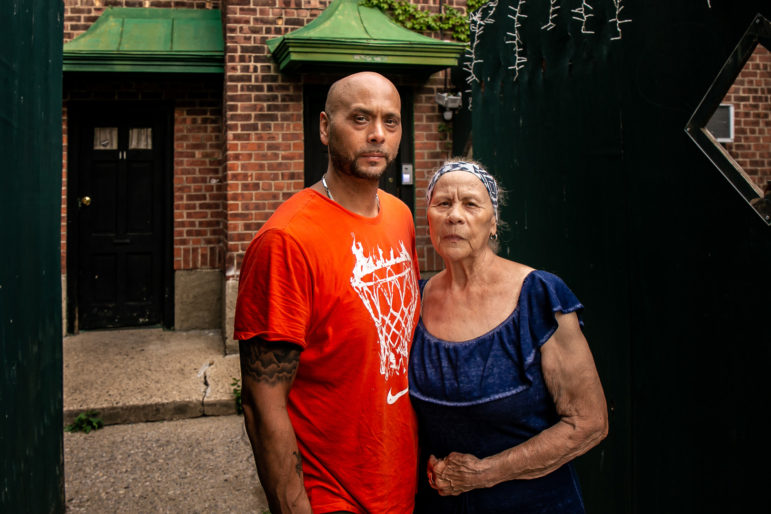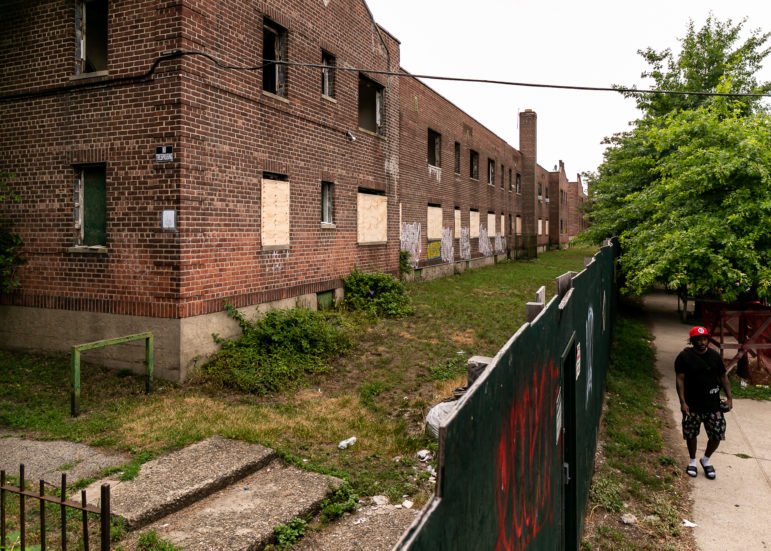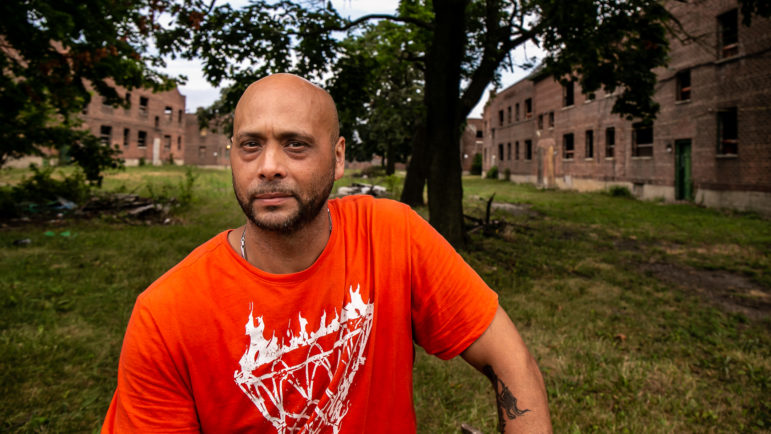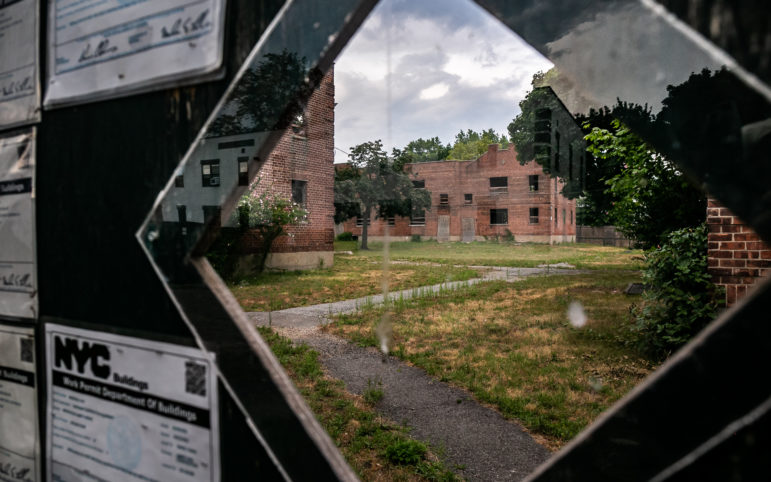Just six units remain occupied in one section of the Arlington Village complex. Now, those who remain worry about what the owners’ plan to develop the site will mean for them. “What exists now won’t exist.”

Adi Talwar
Hector Reyes, 46, with his mother Maritza in front of their apartment in Arlington Village, Brooklyn. Reyes has lived there for 45 years.This story was produced as a collaboration between City Limits and THE CITY.
When Hector Reyes was growing up, his side of Arlington Village was a vibrant community.
Neighbors in his brown brick building, one of two sections in the East New York apartment complex, used to organize barbecues in its grassy courtyard, flipping burgers as he and his friends ran around, he recalled.
But as Reyes, now 46, grew older, he watched families around him disappear as past owners let the property fall into disrepair. Today, Reyes’ family is one of just a handful left in six occupied units of the ramshackle brick dwelling, where green boards and wooden slats cover what were once windows and doors.
Now, they’re worried that even this crumbling home will be taken away from them.
Last fall, the Arlington Village owners presented a plan to Brooklyn’s Community Board 5 that envisioned replacing the two-story brick buildings containing 210 units with two modern, glass high-rises reaching as high as 14 floors.
The property owner promised to bring hundreds of additional “affordable” units to the site but made only vague promises about its “hope to keep” longtime residents in the community — fueling fears of displacement.
“We’re frustrated because they’ve got us living like this and all he’s trying to do is to get us out of the apartment,” Reyes said. “You’ve got so many people looking for homes and they have so much rental space, but instead of working with people it’s all about money.”
In response to questions from City Limits and THE CITY, a spokesperson for David Levitan, the principal developer behind the project, said the plans have changed since that community board presentation. Levitan and his investor group still want to file a rezoning proposal that would enable them to build two massive complexes in the future, he said, but in the near term, they only plan to demolish one of the two sections in the complex and build a single tower in its place. They’ve offered existing residents apartments in the remaining, recently refurbished section of the complex, with the same rents.
“We are excited to work with the tenants and the community to get this project moving so that we can build something that helps tackle the housing shortage and gives the community the amenities that they want and deserve,” said spokesperson Rich Bamberger.
But existing tenants and local housing advocates told City Limits and THE CITY that they had never been informed of this apparent about-face.
And while the investors say they are holding off demolition for one of the existing buildings, they concede that they would like to replace the other — currently occupied by dozens of rent-stabilized tenants — with a new tower about 10 years down the road.
That goal, tenants assert, could incentivize the owners to cut off services and ignore repairs, just like they have in the brown brick building Reyes and his family have seen fall apart under past landlords over the past three decades. Tenants in rent-stabilized apartments are entitled to a lease renewal, but the owner could opt to keep their units vacant if they choose to leave.
“That’s news to me that they’re going to do it in 10 years,” Reyes said. “Are they going to do the same thing to everyone else that they’re doing here?”
Scenes from around Arlington Village, where just six units remain occupied. Photos by Adi Talwar.
Fears of Displacement
This isn’t the first time Arlington Village residents have feared losing their homes.
In 2015, a group of investors purchased Arlington Village ahead of a controversial neighborhood-level rezoning pursued by Mayor Bill de Blasio that aimed to spur more development in the low-rise area. But after rallies and negotiations with local elected officials, the city agreed to carve Arlington Village out of the 190-block upzoning plan for East New York.
Subsequently, the new ownership group renovated and repainted one of the Arlington Village sections — while leaving roughly 100 hollowed-out apartments on Reyes’ side to sit vacant and boarded up.
Six years later, a representative for the property owners presented the new plan for two high-rise buildings with a majority of units to be rented at market-rate, the kind of development residents had fought to keep out.
That proposed project would feature 2,195 apartments, including 1,636 without price limits and 559 reserved for low- and middle-income renters under the city’s Mandatory Inclusionary Housing program. Under current land use rules, Levitan could only add an extra floor to the two-story buildings currently on each lot. To build higher, the developer would need the city to rezone the site to authorize the construction of medium-density apartments there — a decision that is traditionally left up to the district’s City Council member.
Even if the company is only immediately planning to erect one new building, that could still bring more than 846 market rate and 282 “affordable” units to the area. Residents say they still have concerns about the project’s affordability and potential to fuel gentrification in the broader area.
“It will be like Williamsburg. You go into the neighborhood and it’s totally different,” said Olimpo Barco, a Vietnam War veteran and former postal worker who first moved to Arlington Village in 1981. “It’s going to be professional people who can afford it…. We’re the working people. They have to do more for us.”
City inspectors have previously uncovered numerous code violations at buildings owned by Levitan, a well-connected landlord who scored numerous shelter contracts during former Mayor Bill de Blasio’s push to house the homeless. Those infractions include rat infestations, broken elevators, and collapsed staircases.
‘A Competition of Rents’
Olimpo echoed persistent critiques of the 2016 rezoning plan, which has added thousands of new apartments to the neighborhood, but few priced for low-income residents.
Under city rules, developers in rezoned areas must cap rents on 25% to 30% of the apartments they build. Yet units considered “affordable” by the city are often priced for households earning double East New York’s median household income, which stands at $44,270, according to Census data. About a quarter of all residents in Brooklyn’s Community District 5, which includes East New York, earn less than $20,000 a year.
Jessica Franco, a steering member with the Coalition for Community Advancement, a local group opposed to rezoning Arlington Village, fears that the new development will fuel more market-rate building in the area, bringing in a flood of wealthier, white residents whose tastes and buying power will make her neighborhood “look like Downtown Brooklyn.”
“What we see is just a competition of rents,” she said.
Landlords will likely seek higher-paying residential and commercial tenants, she said.
“It’s very easy to replace a small mom-and-pop coffee shop with a Starbucks,” she added. “And folks who can afford to pay $3,000 for a two-bedroom can absolutely afford to pay $8 for a coffee.”
Today, the blocks south of Arlington Village near the A and C train line are peppered with portents of change: green construction boards covering up vacant lots, a handful of modern, cookie-cutter apartments that dwarf the older two- to three-story family homes, and young white couples getting off at train stops where they were rarely seen a decade ago.
At the same time, East New York and communities across Central Brooklyn are facing a lack of affordable housing, and the developer says the 14-story plan promises to bring more than 200 income-capped units to the area and help meet the need.
A January report commissioned by the Real Estate Board of New York, a top industry trade group, found that New York City must create 560,000 new housing units by 2030 to keep pace with its rising population.
“For over a decade New York City’s housing production has failed to keep pace with population and job growth, leading to higher rates of overcrowding and other indicators of housing deficiency,” the industry-backed study said. “Without substantial new residential development, the City’s housing deficit could worsen, as pipeline development does not yet support growth anticipated through 2030.”
This year, developers are on pace to construct about 16,000 affordable units, administration officials told the City Council in May (short of the city’s goal of 20,000 units a year, HPD Commissioner Adolfo Carrión said recently). Mayor Eric Adams has pledged to support new projects and make New York a “City of Yes” by overriding opposition to new housing.

Adi Talwar
July 28, 2022: Arlington Village, Brooklyn.Another Upzoning?
But East New York has already absorbed plenty of new development, said Councilmember Sandy Nurse, who was elected to represent the neighborhood last year.
Nurse said she understands the need for more housing, but encouraged investors to look outside her district, where 6,400 new apartments are planned by 2030.
“If you have already upzoned a place, why are we asking for another upzoning,” she said, adding that she supports a “comprehensive planning framework” for the city—not lot-by-lot decision-making.
More affordable units are in the works for East New York, according to the Department of City Planning (DCP). The city has so far financed 1,194 income-restricted units in the rezoning area, including 312 for households earning less than 30 percent of area median income (about $36,000 a year for a family of three), DCP data shows. Still, just 100 units with rents capped for low- and middle-income earners had actually opened between the 2016 rezoning and the end of de Blasio’s tenure, Gothamist reported last year. Another 218 income-restricted units opened in June in a building at 50 Pennsylvania Ave.
A DCP spokesperson said the agency has not received a formal application or pre-application materials for an Arlington Village rezoning, but officials have discussed plans with the owners. The agency said they could not provide more specifics.
Any plan to create a new megadevelopment at Arlington Village will likely depend on Nurse, since the full Council traditionally votes in lockstep with the local member on land use issues in their district.
She said she will defer to current tenants when making a decision on whatever plan comes before her.
“Once residents articulate a position, I will support that,” she said.
The process by which the residents of Arlington Village are supposed to come to a consensus remains unclear. In the meantime, some tenants have begun organizing to get their neighbors to oppose the development plan.
On a hot Saturday afternoon earlier this month, a few dozen tenants and anti-rezoning activists hosted a barbecue in the enclosed courtyard on the renovated side of Arlington Village, where they chatted about the development proposal and hosted a workshop on youth empowerment.
Older residents sat in a circle of lawn chairs under the trees that dot the courtyard and munched on watermelon slices to keep cool. Next to them, their grandchildren tackled each other on the grassy lawn and horsed around in the buzzing sprinkler.
Standing in the shade of a building wall, Sonia Barco, a 60-year-old Ecuadorian-American tenant and a relative of Olimpo through a former marriage, said seeing the new proposal hit her hard.
“Arlington Village is our home. So I felt a profound feeling when I saw that building of 14 floors, to see there’s no green space, there’s only a building,” said Barco, who has lived in the complex for more than 30 years. “What exists now won’t exist. We won’t have this privilege that we have now in the middle of Brooklyn to have these trees, to have this green zone.”
Barco said she is hopeful Nurse will champion her and her neighbors’ opposition when a rezoning proposal reaches the Council.
But other long-time tenants milling around outside that day were more skeptical.
Luis Rodriguez, a retired bus operator, said Arlington Village, the community he has called home for nearly 50 years, cannot escape change.
When he was a kid, the complex was majority Italian and Irish, but those residents gradually left in the White Flight era, leaving the disinvested property to Black and Hispanic residents. Now, the pendulum is swinging again, he said, like it already has in Bushwick and Downtown Brooklyn, because there’s money to be made.
“Money is power. It’s gonna take time and the guy [will] say, ‘Alright, I’ll wait, I got my lawyers and all that. Sooner or later, I’m gonna do it,’” said Rodriguez, 62, referring to the building’s owners. “I mean, it could be next year, it could be five years, could be 10 years. He’s gonna have it done.”
The wife of George Joseph, one of the authors of this piece, was previously an intern with the Cypress Hills Local Development Corporation, one of the groups opposed to the Arlington Village rezoning proposal.














6 thoughts on “East New York Families in Limbo as Developer Plans High Rise to Replace Crumbling Housing Complex”
‘…fears that the new development will fuel more market-rate building in the area, bringing in a flood of wealthier, white residents…’
LOL! LOL! Middle-Class renters of all races know to avoid East New York. LOL! LOL!
I lived in The Village as we called it for years. I moved there with my family in 1973. What a beautiful place it was. Back then you had the landlord Fred Starr that keep the place intact but, when he passed and left it to his daughter. She had no love for the place. I could tell you SO many good stories & memories. I still remember the Supers at that time. Good guys. You would put your garbage outside & they had a pick up truck & come get your garbage for you. Christmas time there was a Big Pine tree about 20 ft. & they would put lights on it. Back than you had a mix of, Italians, Jews, Germanys, Irish & some Spanish. It was a great time indeed. Everyone knew everyone. We all played softball, football, handball, stickball & scaly etc… You just had to be there. Sad what it’s become & been for YEARS A DUMP!
ALL THIS REMODELING AND UPGRADING IS JUST FOR THE WHITE ELITE THIS IS WHAT MAKE SOME PEOPLE HAVE A ISSUE WITH WHITE PEOPLE FEEL LIKE THEY ARE TAKING OVER OUR NEIGHBORHOODS AND NOT CARING WHAT THE FAMILIES GOING THROUGH THAT’S BEEN HERE FOE YEARS. WHEN THEY GET TIRED THEY GO BACK TO MANHATTAN OR WHEREVER THEY CAME FROM BUT I KNOW SOME OF THEM HAVE LOW INCOME APARTMENTS CAUSE THEY PAY THE PEOPLE UNDER TABLE CAUSE THEIR SALARIES ARE MORE THAN REQUIRED IM JUST SAYING WHAT I KNOW IM NOT PREJUDICE I HAVE A LOT OF CAUCASIAN FAMILY MEMEBES
“Our neighborhoods” ha. My working-class white family lived a short walk from Arlington Village for 70 years, 4 generations. It was a majority white wc area for most of the 20th century. What brought it down was the massive change in immigration laws in the ’70s, the drug/crack wars in the ’80s and ’90s, Section 8 housing and welfare, absentee homeowners who started renting out their single-family, attached frame rowhouses to people to live together who weren’t related, one kitchen, one bathroom, explosion of basement apts. that weren’t legal, and the flooding of the neighborhood with illegals from Central, South America, the Caribbean, chain migration, and the Christian churches helping the effort. Now with the Brooklyn glorification in real estate, the push along the train lines from Williamsburg, Bushwick, into ENY and Cypress Hills was bound to happen. What that neighborhood has long needed is a stable middle- and working-class of people. The “white flight” was not about race or ethnic backgrounds of people moving in; the area had a lot of mixed people who worked. The flight away was from drugs, crime, gangs, fires, when foreign people with wildly different behaviors/values from Americans, flooded into the area. For the remaining whites, there was plenty of anti-white bias and really, foreign vs. American. I lived in area 1950-1972, married, moved back to help my elderly mom from 1978-1992, when family sold my grandparents’ house they bought in 1922. It was a single-family, attached frame house in middle of block. It’s on the market now, after a complete gutting by a developer for $599,000. Astonishing–deBlasio had his eye on this part of B’klyn from time he visited St. Rita’s Church right across from Arlington Village during his mayoralty. He was always in bed and profiting from his deals with greedy real estate developers. He was quoted as saying words to the effect about he didn’t know this part of B’klyn, but had eyed Atlantic Avenue and some lots that had potential during his car ride over from Manhattan.
my name is vivian rivera . i came to live there when i was a wrong girl . till this day my famil still live there i still visit. keep it open it’s a great place to live .
thank you for sharing!